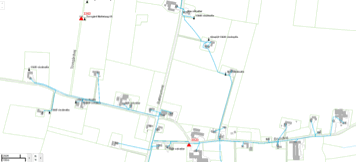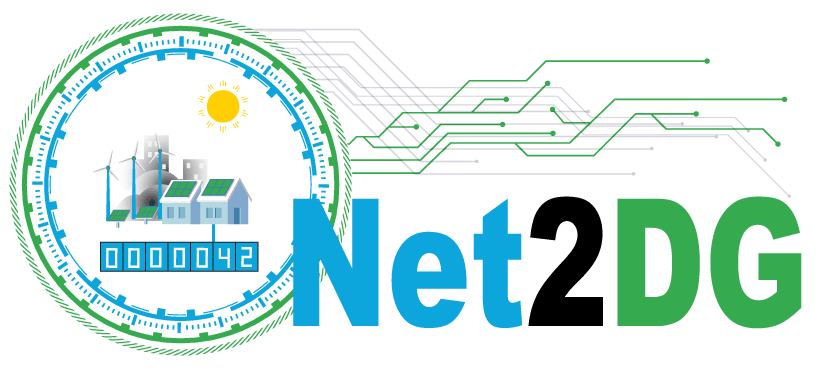Due to the simple static worst case calculations, there is a lack of knowledge about the actual Power quality situation, in particular in the LV grid. PQ measurement devices have been deployed in several secondary substations, but the provided measurements have not yet been processed. Furthermore, there have been problems reported by the higher-layer grid operator that too much capacitive reactive power has occurred in the primary substation.
Therefore the field-tests deployment of the Net2DG solution will address two questions:
1.) Characterize the power quality in the LV grid based on the measurements at the substations and based on Smart Meter and Inverter-based measurements.
2.) Understand the time evolution of the reactive power and cos phi in selected parts of the LV grid and apply mitigation measures to optimise local balancing fociusing on solving capacitive reactive power flows at the primary substation.
Figure 1: A typical configuration of a LV grid of Thy-Mors Energi which shows voltage issues

Thy-Mors Energi (TME) is a Danish DSO located at the North-Western part of Jutland. The test area covers roughly 100 km2 and is one of the rural areas of Denmark with quite a lot of typically sized smaller towns spread around.
The test area is well known to be windy and thus wind generation at household levels is not uncommon here, in addition to residential PV systems. Overall there are approximately 75 PV's and wind turbines in the area. Small 10/0,4kV substations are installed with the same meters as the consumers and provide measurements of energy and voltage with 15 minutes intervals on 3 phases. On the low voltage side, Thy-Mors Energi has recently deployed the whole area with new smart meters from the company Kamstrup, which can provide 15 min. intervals of updated information of voltages, power and events in the grid.
Grid scenario B - Thy-Mors Energi
Grid scenario A - Stadtwerke Landau a.d. Isar
Voltage Quality
This application will determine and visualize voltage quality parameters in distribution grids using available data from various measurements systems and from the grid estimation algorithms. In particular of interest is to characterize properly voltage variations, voltage dips/sags, long and short voltage interruptions and voltage unbalances and asymmetries in distributions grids with high penetration of fluctuating renewable energy. Some of the existing National and European Standards e.g. EN50160, IEC 61000 and VDE, DEFU are computing these values using typically average values of around 10 min. Solar PV generation especially in fast moving clouds condition can generate large and very rapid power fluctuations which has a significant impact on voltage profiles during low load situations. The goal here is to characterize properly the voltage quality according to these new renewable generation profiles; classify and prioritize the events that may endanger the daily grid operation and generate warnings and trigger signals. Warning signals will be visualized to DSO staff; furthermore, the obtained voltage quality parameters will also be input to functionalities that coordinate control actions, specifically in Net2DG a coordinated approach to OLTC, load activation, and residential inverter envelope adjustment.
Grid Operation Efficiency
This application will estimate the dynamic behaviour of grid losses in the observed LV grid(s). Warnings will be triggered when specific thresholds will be exceeded including prioritization and classifications. These algorithms should be able to identify between increase in losses due to normal grid operation scenarios under various generation and consumption profiles and abnormal cases such as unregistered consumers and fault situations. In particular the phase to ground faults may be "seen" as an unregistered consumer. Identifying the locations of fault or the unregistered consumers is also relevant for daily grid operation. The above algorithms will use all available information provided by the available measurement systems as well as the output of the grid estimation algorithm. The warning signals generated will be made available to the DSO staff, but also will trigger specific control functionalities according to the registered event; for the latter, Net2DG focuses on a coordinated approach to dynamic On-Load Tap Changer (OLTC) and residential inverter envelope adjustment for loss reduction.
All Rights Reserved - Net2DG © 2021
Applications
Grid-Outage Diagnosis
This application will identify and diagnose outages in the LV distribution grid by using the available measurements and information from considered systems including grid estimation algorithms. In particular it is of interest to localize outages in LV grids where isolation of faulted feeders and grid reconfiguration is not available as in the MV level. The application will use potentially available measurements from secondary substations and correlate this information with ICT unreachability information and where available measurement values from the different grid connected meters and inverters. Furthermore, special notifications from the latter devices will be utilized; in particular grid inverters equipped with island detection algorithms can generate signals regarding grid presence in their point of connection. Some smart meters are able to send notifications about decaying voltages of the main supply to the concentrators before their communication interface become deactivated. Finally, also post-incident diagnosis will be possible, as some Smart Meters and Inverters continue to measure the main supply and buffer locally these values despite deactivating its communication interface due to lack of supply. By sorting and mapping these signals using the algorithms for outage detection information about fault localization and extent can be obtained. Warning signals containing type of outage and the affected customers will be generated automatically by these algorithms or diagnosis may be triggered by the operator based on other events. Interfacing and visualization to the Distribution System Operator (DSO) staff can provide valuable information for restoring rapidly the power supply in the faulted area.

The distribution grid of Stadtwerke Landau a.d.Isar consists of a 20kV medium voltage grid with 101km cables and 33k overhead lines which is connected by two primary substations to the HV grid operated by a different company. The low-voltage grid is served by 180 secondary substations with a total installed power of 60MVA; this grid part is realized by 327km cable and serves 4200 residential households (among a total of 8300 metering points in the distribution grid). The distribution grid covers both the town of Landau and the neighboring rural areas. The region contains a high penetration of PV, with in total 1235 PV generators and an installed power of 26MVA.
The grid has been reinforced in the last 15 years in order to be able to accommodate such high PV generation. Regarding voltage quality however, the situation in the MV grid is evaluated by a static simulation using DigSilent for a worst case scenario of full generation and zero loads, and only simple static calculations via an xls file are performed when connecting PVs newly to the LV grid; when this singular calculation leads to a voltage deviation of 3%, grid topology or substation adjustments will be implemented.
Figure 1 shows a selected LV grid in which voltage problems have been observed in the past. Overvoltages have been observed, while the wind turbines and PV's in the grid were active and occurring during periods of low loads. In worst case, the wind turbines and PV's may have to be disconnected from the grid due to voltage rise effect. It is therefore desirable for Thy-Mors Energi to detect such voltage violations and to derive online and offline counteractions to avoid situations where voltages go too high or too low. While TME generally has possibilities to actuate the wind turbines and PVs, the economic consequences have to be considered and hence such decisions have to be carefully evaluated.
Due to the highly distributed nature at Thy-Mors area, the LV grids are typically radial topologies and therefore no redundancies exist in the LV grid as it does in the MV grid. Therefore, it is important to detect if the grid is about to fail or if it failed to know what happened such proper action can be taken to avoid customers being left without power. Another goal of the field-tests is to show that the Net2DG solution can use inverter and Smart Meter data together with substation measurements in order to obtain reliable measurements of the behavior of LV grid losses with time granularities ranging between 15min and one day. So far, only a rough estimate of grid losses is provided by static simulations of the grid. The expectation is that the detailed measurement-based behavior of LV losses will show dynamic patterns which also open up for loss minimization aproaches via intelligent control and coordination solutions; the latter are outside the scope of the field trial but will be investigated in lab tests.
A second aspect to be investigated in this scenario is the ICT connectivity: Due to the rural region, cellular coverage is not available in all places or of very time-varing properties, and dedicated fiber networks can be very costly. Therefore, intelligence to deal with fluctuation connectivity is investigated as part of the TME field test.
